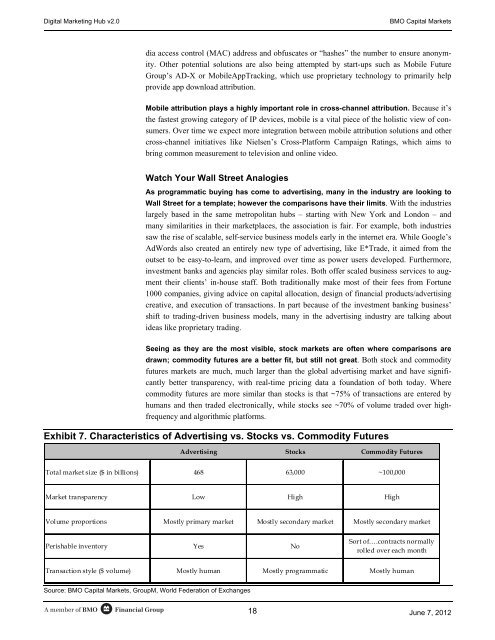DIGITAL MARKETING HUB v2.0 - AdExchanger
DIGITAL MARKETING HUB v2.0 - AdExchanger
DIGITAL MARKETING HUB v2.0 - AdExchanger
Create successful ePaper yourself
Turn your PDF publications into a flip-book with our unique Google optimized e-Paper software.
Digital Marketing Hub <strong>v2.0</strong><br />
BMO Capital Markets<br />
dia access control (MAC) address and obfuscates or “hashes” the number to ensure anonymity.<br />
Other potential solutions are also being attempted by start-ups such as Mobile Future<br />
Group’s AD-X or MobileAppTracking, which use proprietary technology to primarily help<br />
provide app download attribution.<br />
Mobile attribution plays a highly important role in cross-channel attribution. Because it’s<br />
the fastest growing category of IP devices, mobile is a vital piece of the holistic view of consumers.<br />
Over time we expect more integration between mobile attribution solutions and other<br />
cross-channel initiatives like Nielsen’s Cross-Platform Campaign Ratings, which aims to<br />
bring common measurement to television and online video.<br />
Watch Your Wall Street Analogies<br />
As programmatic buying has come to advertising, many in the industry are looking to<br />
Wall Street for a template; however the comparisons have their limits. With the industries<br />
largely based in the same metropolitan hubs – starting with New York and London – and<br />
many similarities in their marketplaces, the association is fair. For example, both industries<br />
saw the rise of scalable, self-service business models early in the internet era. While Google’s<br />
AdWords also created an entirely new type of advertising, like E*Trade, it aimed from the<br />
outset to be easy-to-learn, and improved over time as power users developed. Furthermore,<br />
investment banks and agencies play similar roles. Both offer scaled business services to augment<br />
their clients’ in-house staff. Both traditionally make most of their fees from Fortune<br />
1000 companies, giving advice on capital allocation, design of financial products/advertising<br />
creative, and execution of transactions. In part because of the investment banking business’<br />
shift to trading-driven business models, many in the advertising industry are talking about<br />
ideas like proprietary trading.<br />
Seeing as they are the most visible, stock markets are often where comparisons are<br />
drawn; commodity futures are a better fit, but still not great. Both stock and commodity<br />
futures markets are much, much larger than the global advertising market and have significantly<br />
better transparency, with real-time pricing data a foundation of both today. Where<br />
commodity futures are more similar than stocks is that ~75% of transactions are entered by<br />
humans and then traded electronically, while stocks see ~70% of volume traded over highfrequency<br />
and algorithmic platforms.<br />
Exhibit 7. Characteristics of Advertising vs. Stocks vs. Commodity Futures<br />
Advertising Stocks Commodity Futures<br />
Total market size ($ in billions) 468 63,000 ~100,000<br />
Market transparency Low High High<br />
Volume proportions Mostly primary market Mostly secondary market Mostly secondary market<br />
Perishable inventory Yes No<br />
Sort of….contracts normally<br />
rolled over each month<br />
Transaction style ($ volume) Mostly human Mostly programmatic Mostly human<br />
Source: BMO Capital Markets, GroupM, World Federation of Exchanges<br />
A member of BMO<br />
Financial Group<br />
18<br />
June 7, 2012


